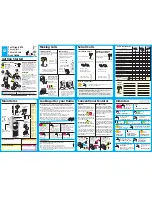
2
TEST INSTRUMENT SAFETY
Normal use of test equipment exposes you to a certain amount of danger from electrical shock because testing must sometimes be performed
where exposed voltage is present. An electrical shock causing 10 milliamps of current to pass through the heart will stop most human
heartbeats. Voltage as low as 35 volts dc or ac rms should be considered dangerous and hazardous since it can produce a lethal current under
certain conditions. Higher voltages pose an even greater threat because such voltage can more easily produce a lethal current. Your normal
work habits should include all accepted practices to prevent contact with exposed high voltage, and to steer current away from your heart in
case of accidental contact with a high voltage. You will significantly reduce the risk factor if you know and observe the following safety
precautions:
1.
Connect the NTSC Generator’s ac power cord only to a 3-wire outlet to assure that the instrument’s chassis and ground leads or probes
ore test cables are at earth ground.
2.
Don't expose high voltage needlessly to the equipment under test. Remove housings and covers only when necessary. Turn off equipment
while making test connections in high-voltage circuits. Discharge high-voltage capacitors after removing power.
3.
If possible, familiarize yourself with the equipment being tested and the location of its high voltage points. However, remember that high
voltage may appear at unexpected points in defective equipment.
4.
Use an insulated floor material or a large, insulated floor mat to stand on, and an insulated work surface on which to place equipment;
and make certain such surfaces are not damp or wet.
5.
Use the time proven "one hand in the pocket" technique while handling an instrument probe. Be particularly careful to avoid contacting a
nearby metal object that could provide a good ground return path.
6.
When testing video equipment that includes a picture tube or CRT, remember that the high voltage power supply and CRT anode operate
at very high voltage, often 20,000 volts or more. Carefully void these areas when the equipment is operating. It is also typical for these
circuits to retain a high voltage charge long after the equipment is turned off. Before attempting any servicing with the power removed,
discharge high voltage pints. Also avoid bumping the CRT with a sharp edge. Because of the high vacuum, a nicked CRT may “implode”
and cause flying glass fragments.
(continued on inside rear cover)
WARNING
Summary of Contents for 1249B
Page 1: ...INSTRUCTION MANUAL Model 1249B NTSC GENERATOR ...
Page 16: ...16 THE NTSC COLOR VIDEO SIGNAL CONT Fig 3 Elements of Color Television Signal ...
Page 20: ...20 CONTROLS AND INDICATORS CONT Fig 4 Controls and Indicators ...
Page 35: ...35 MAINTENANCE CONT R7 Fig 8 Adjustment and Test Point Locations ...



































